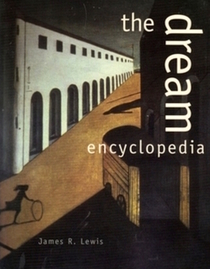Helpful Score: 1
Very informative. Covering a wide area of interest. Includes dream symbols.
From Booklist
With 250 entries, The Dream Encyclopedia covers the role of dreams from the Gilgamesh epic to the theories of Sigmund Freud. Lewis is the author of The Astrology Encyclopedia [RBB Ag 94] and The Encyclopedia of Afterlife Beliefs and Phenomena [RBB Ap 15 95]. His new work includes scientific information on sleep and information on the place of dreams in religion and anthropology. For example, entries on religions and ethnic groups from around the world discuss the importance of dreams to those cultures. Entries range from one to four pages and end with bibliographies of sources for additional information. Black-and-white photographs accompany many of the articles. Arranged alphabetically, the encyclopedia is easy to use, and cross-referencing is accomplished by using boldface type. A section on dream interpretation, with more than 700 symbols and what they are supposed to mean, follows the encyclopedia. An appendix lists addresses of organizations and laboratories that do dream research. A subject index provides additional access.
The work does have some flaws. For example, Patricia Garfield is mentioned in the entry Healing and Dreams, but her name is not boldfaced to refer to her own entry. The same is true of Cicero in the article on Rome. One can also quarrel with certain omissions. While there are entries for authors (e.g., Chaucer), Samuel Taylor Coleridge's dream that became "Kubla Khan" is omitted. Some entries suffer from lack of depth. For example, the article Sleep Learning states that memory shuts down so learning cannot take place in sleep but provides little explanation of this beyond references to other sources.
With 250 entries, The Dream Encyclopedia covers the role of dreams from the Gilgamesh epic to the theories of Sigmund Freud. Lewis is the author of The Astrology Encyclopedia [RBB Ag 94] and The Encyclopedia of Afterlife Beliefs and Phenomena [RBB Ap 15 95]. His new work includes scientific information on sleep and information on the place of dreams in religion and anthropology. For example, entries on religions and ethnic groups from around the world discuss the importance of dreams to those cultures. Entries range from one to four pages and end with bibliographies of sources for additional information. Black-and-white photographs accompany many of the articles. Arranged alphabetically, the encyclopedia is easy to use, and cross-referencing is accomplished by using boldface type. A section on dream interpretation, with more than 700 symbols and what they are supposed to mean, follows the encyclopedia. An appendix lists addresses of organizations and laboratories that do dream research. A subject index provides additional access.
The work does have some flaws. For example, Patricia Garfield is mentioned in the entry Healing and Dreams, but her name is not boldfaced to refer to her own entry. The same is true of Cicero in the article on Rome. One can also quarrel with certain omissions. While there are entries for authors (e.g., Chaucer), Samuel Taylor Coleridge's dream that became "Kubla Khan" is omitted. Some entries suffer from lack of depth. For example, the article Sleep Learning states that memory shuts down so learning cannot take place in sleep but provides little explanation of this beyond references to other sources.
From the back cover:
This encyclopedia examines 250 dream-related topics from art to night terrors, including dream control, healing and dreams, nightmares, ESP and dreams, falling dreams, Shakespeare and dreams, sex and dreams, Thomas Aquinas and dreams, creative visualization, problem solving in dreams, the collective unconscious, Native American dream interpretations, day residues in dream content, memory and sleep, and nondreamers. More than 700 dream symbols are defined in a separate 100-page section.
This encyclopedia examines 250 dream-related topics from art to night terrors, including dream control, healing and dreams, nightmares, ESP and dreams, falling dreams, Shakespeare and dreams, sex and dreams, Thomas Aquinas and dreams, creative visualization, problem solving in dreams, the collective unconscious, Native American dream interpretations, day residues in dream content, memory and sleep, and nondreamers. More than 700 dream symbols are defined in a separate 100-page section.
Exploring 250 intriguing topics, from art and dreams to night terrors, The Dream Encyclopedia illustrates how dreams influence culture, religion, history, art, literature and our personal lives.




